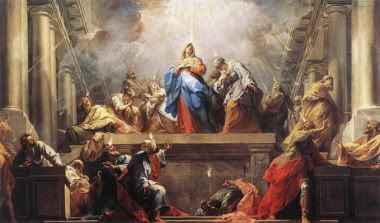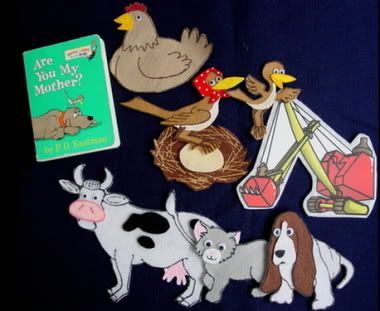
It is common to look to the Feast of Pentecost as the birth-day of the church. If we can say that the Church was conceived in Matthew 16:18 with Jesus’ words to St Peter near Caesarea-Philippi, “You are Peter, and on this rock I will build my Church,” then we should say that Pentecost is the church’s joyous birth when she manifests to the world the gifts of the spirit and like a newborn baby, cries out to the world with a vigorous proclamation of the Gospel.
As it is also Mother’s Day, my mind is taken back to the image of the Virgin Mary, who is often pictured in the center of paintings of Pentecost (like the one above), awaiting with the disciples in the Upper Room, as Acts tells us, the promised outpouring of the Holy Spirit, signified in the tongues of fire illuminating their minds with God’s truth and in the miracle of languages to proclaim the Gospel.
May is the month of devotion to the blessed Virgin Mary. As Our Lady is called the Virgin Mother of God, so also is she looked upon as the Mother of those who find new life in the Savior she bore. She is likewise the first Christian, who heard the Word, responded in faith, carried Christ within her, followed him to the cross, and suffered along with him as he bore his passion. She is the Christian prototype.
As it is Mother’s Day, my mind is also drawn back to that famous quote from St Cyprian, Bishop of Carthage in Northern Africa. About AD 250, he asked rhetorically, “Can one have God as his Father, before one has had the Church for his Mother?”
Perhaps you remember the children’s book, Are you my Mother? by P.D. Eastman. It was a favorite of mine growing up, and I think it may help us to learn more about holy Mother Church today. If you have ever changed denominations or moved to a new city and looked around for a church, you can empathize with the bird’s search in this book: “Are you my mother?”

The story begins when an egg begins to twitch. The momma bird knows her egg will soon break and goes to find some food for her newborn. Sure enough, the egg hatches while she is away getting a worm. The baby bird stumbles out of the nest in search of his mother. He comes first to a kitten, then a hen, a dog, and a cow. “Are you my mother? Did I have a mother,” the baby bird thinks to himself. “I know I did. I will find her.” So he wanders on looking for mom.
He runs into an old car, a boat, and an airplane. But these are not his mother either. He then hops into the digging bucket of a backhoe. “Are you my mother?” The contraption lets out a “Snort!” and rumbles to life. The bird is caught in the rising arm of this crawler, being transported to some unknown destination.
Just when he thought he was about meet his end, the bucket dumps the bird back into his own nest in his own tree. And there is a creature who looks very much like himself and has a fresh meal waiting for his hungry belly. “Do you know who I am?” she said to the baby bird.
“Yes, I know who you are. You are not a kitten, a hen, a dog, or a cow,” he said. “You are not a car, a boat, a plane, or a snort. You are a bird, and you are my mother.” Once the little bird saw his mother, the contrast became quite obvious. None of these other things looked even remotely like his mother.
St John, to whom Jesus entrusted Mary as his mother at the cross, used this kind of high contrast in the Book of Revelation to illustrate the nature of our holy Mother Church. There is no confusing the Christ and the anti-Christ or the church and the world. The forces of evil are pictures as a seductively-clad harlot, full of abominations, drunk on the blood of the saints. She is the personified goddess Roma, riding on the back of the empire—the beast with seven imperial horns, trampling over the nations of the earth. Who could possibly confuse this with the Church, the spotless bride dressed in the purest linen, and a jewel-encrusted city with room for all coming down from heaven, the eternal home for the bride to share with Christ, her beloved husband.
“Are you my mother?” How do you know? What does the church look like? In confirmation class, we talk about the four “marks” of the church in the creed. The Church is "One, Holy, Catholic, and Apostolic." The Church is One (in spite of all our efforts to the contrary) because our Lord is one. Christ is not divided, and the church is his body, united to Christ as its one head.
The Church is Holy (despite all our shortcomings in the moral life) because it is the temple of the Holy Spirit. "Holy" Church is a way of saying that we are a community that belongs to God.
The Church is Catholic (which means we are Catholics) because we hold the faith together—that which has been believed “everywhere, always, and by all”—not because we hold some unique modern or American version of the faith. We could say that the local church only is the Church, insofar as it is the local manifestation of the Universal Church.
The Church is Apostolic, because it comes to us from the apostles themselves and carries on their apostolic zeal for the Gospel and witness to the risen Lord. “Are you my mother?” We remind ourselves each Sunday in the Nicene Creed what the Church (momma bird) is supposed to look like.
Of course, these are not the only attributes of the Church, though we must have those four. It is schismatic to depart from the Unity with Christ, the Holiness of life, the Catholicity of faith and the Apostolicity of ministry that God entrusted to his Church. These are non-negotiables.
On Pentecost, we are also reminded that the Church is a gifted community. When the Church was filled with the Holy Spirit, she immediately manifested the gifts that come with that empowerment. The first sign was the gift of tongues to spread the Gospel.
There are a myriad of spiritual gifts that God has imparted to his Church through the Holy Spirit. St Paul explains in today’s epistle, “To each is given the manifestation of the Spirit for the common good,” and he mentions some of these: wisdom, knowledge, words of faith, healing, miracles, prophecy, spiritual discernment, tongues and the interpretation of them. “All these are activated by one and the same Spirit,” he said, “who allots to each one individually just as the Spirit chooses.” We can also recognize Mother Church by the giftedness she has and her faithfulness in using spiritual gifts to build up the body of Christ.
Looking at that first Pentecost Sunday, we also note that the Church is missionary. Just before he ascended into heaven, Luke tells us that our blessed Lord told the disciples: “You will be my witnesses in Jerusalem (that is, at home), in Judea and Samaria (a little further out of your comfort zone), and to all the ends of the earth.”
The collect for the day reminds us of this central purpose of the Church: “Almighty God, on this day you opened the way of eternal life to every race and nation by the promised gift of your Holy Spirit: shed abroad this gift by the preaching of the Gospel, that it may reach to the ends of the earth . . .” My mother looks like a missionary. She is hard at work sharing the Gospel with people at home and with people abroad.
Another defining characteristic we see in holy Mother Church is the splendor of truth. In our Gospel today, Jesus said, “I will ask the Father, and he will give you another Advocate to be with you forever. This is the Spirit of truth, whom the world cannot receive, because it neither sees him nor knows him. You know him because he abides with you, and he will be in you.”
The Church receives truth from her Lord—the truth about God, about man, about sin and redemption, about the way of salvation—all these come from God. As the Holy Spirit imparts the gifts of knowledge, wisdom, and understanding, Jesus refers to him as the Spirit of truth who dwells in the Church. We find these revealed truths in the Bible (the written Word) and in the sacred tradition of the Church’s faith. The Holy Spirit guides us by reason into this truth.
“Are you my mother?” In his first letter to Timothy, St Paul described our mother as “the household of God, which is the church of the living God, the pillar and support of the truth.” (1 Tim 3:15)
Finally, we recognize Mother Church because of the love she shares. How did the baby bird in our story know he had found his mother? He found a creature that loved him, that was waiting with his first meal.
In our Gospel, Jesus said, “If you love me, keep my commandments.” At first that may sound a bit pretentious. But what does he mean by that? If we turn back to the previous chapter, we find the answer. Jesus said, “I am giving you a new commandment: love one another. Just as I have loved you, you are to love one another.”
We do this most fully by entering into the inexhaustible love of God. In his theology of the Trinity, St Augustine of Hippo described the third person of the Trinity as the Spirit of love—he is the love that binds the Son to the Father and the Father to the Son.
In the midst of perfect love, we find the bond of perfect unity. Remember that question from St Cyprian posed earlier about “Mother” Church? It came in his book On the Unity of the Catholic Church. After examining the nature and attributed of the church, he comes around to answering his own question. And he closes with a word of caution: “If you leave the Church of Christ, you will not come to Christ’s rewards. You will be an alien, an outcast, an enemy. You cannot have God for your Father unless you have the Church for your Mother.”
“Are you my mother?” My mother loves me, and I can see that she is totally, head-over-heels in love with Jesus, her husband. My mother believes the truth. My mother talks about it all the time, sharing the truth with the world, even to the ends of the earth. And my mother shows the gifts that she has, using them to strengthen our faith and build us up as a family.
You may have been looking for a mother like that, and if that’s the case, welcome home. Come celebrate with us, because it’s mom’s birthday and we’re having a party.


No comments:
Post a Comment